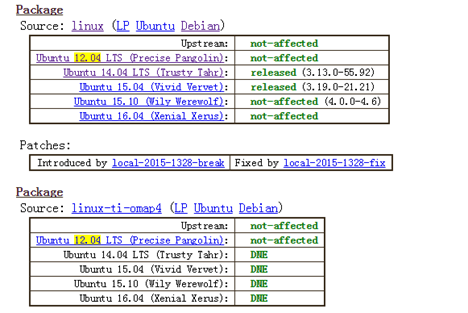前些日子在月赛中,拿到了一台Ubuntu14.04的服务器,但并不是root权限,需要提权。我Google了一下,找到了CVE-2015-1318,CVE-2015-1328,CVE-2015-1338这些可以用来提权的CVE和POC。当我用CVE-2015-1328来提权时,并没有成功,我当时就想知道我这台服务器到底打没打上这个CVE的补丁呢?
后来,我在网上查了下,稍微琢磨了下,就有了这个方法,可能不一定是最方便最好用的。我在Google直接搜索CVE-2015-1328,找到了如下这个链接:
http://people.canonical.com/~ubuntu-security/cve/2015/CVE-2015-1328.html 我在里面看到了受影响的package以及修复信息。截了一部分的图:

我们可以看到是受影响的是Linux的内核。所以执行dpkg –l |grep linux 就可以找到Linux内核的package的名字。在我的Ubuntu 12.02上,截下部分图:

紧接着,使用apt-get changelog linux-image-3.2.0-97-generic就可以看到当前内核版本的changelog,然后直接在里面搜索CVE-2015-1328就可以知道是否打上了补丁。如果打上了补丁,那么这个提权的POC就不能起作用了。其他的CVE也可以利用这种方法来确定是否打上了补丁。
最后来解释几个Linux下的名词:
Upstream kernel:
来自www.kernel.org的kernel, 我们称为upstream kernel,这个Linux kernel由Linus Torvalds领导下的Linux Kernel Organization来维护。我们用的Ubuntu,CentOS等都是Linux的发行版(distribution),这些Linux distribution对由Linux Kernel Organization维护的内核做了些修改,这些内核并不是直接从www.kernel.org得到的内核,称从www.kernel.org 得到的内核为这些发行版内核的Upstream kernel。
我在StackOverflow上也找到了一个比较通俗的介绍。
Using Ubuntu as an example.
Ubuntu is a distribution which packs a lot of software together, small and large. There are graphic drivers, the X server, and Gnome, among others. Ubuntu itself is not developing those software. Ubuntu is "just" packing the software together, making sure that the individual components work together. All that software which Ubuntu is packing together are called upstream from Ubuntu's point of view.
In the process of combining all that software together bugs might pop up. The bug might be in one of the software components, for example gnome, or it might be in the very special way Ubuntu is doing things. After all, a distribution is a distribution because it does some things in it's own very special way.
If the bug is caused by the way Ubuntu is doing things, then Ubuntu will have to fix that bug for itself. If the bug is in fact in one of the software components, for example Gnome, then Ubuntu will have to patch Gnome. When Ubuntu sends the patch back to Gnome, so others can also benefit from the patch, then Ubuntu is sending that patch upstream.
If Ubuntu decides to not send that patch upstream, or the upstream project rejects the patch (but Ubuntu decides to still keep the patch), then Ubuntu has technically forked the project.
The opposite of upstream would be downstream, Ubuntu is downstream from Gnome. I do not hear/read that term used often.
Ubuntu Changelog:
Ubuntu的Changelog记录了软件包随版本的变化。Changelog也有一定的格式,可以从下面的这个链接了解到。
http://packaging.ubuntu.com/html/debian-dir-overview.html